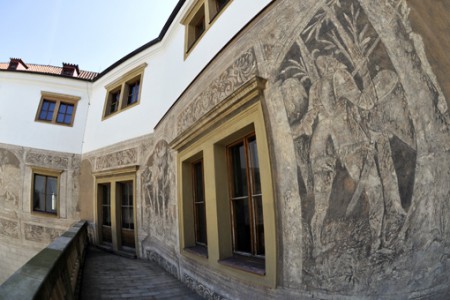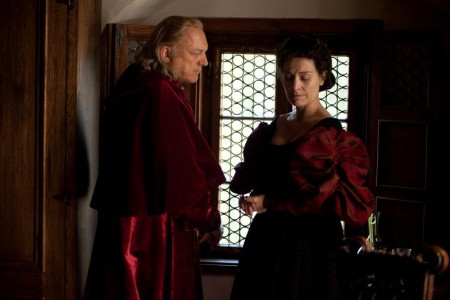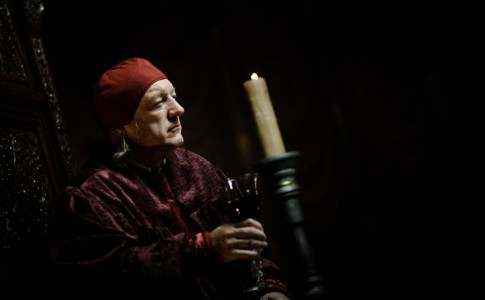The owners of a Renaissance palace in the Czech capital are keeping lavish sets created for a television miniseries set in 15th-century Rome.
The 16th-century Martinitz Palace, located on a quiet corner of the square in front of Prague Castle, is regarded as one of the greatest examples of Renaissance architecture in a city famed for the splendour of its historical buildings.
The four-storey structure features impressive examples of sgraffito wall decor, along with a marble coat of arms of its original owners, the Martinitz noble family.
However, for a very long time the palace’s interiors were another matter entirely. When the last of the family line, Jaroslav Martinitz, passed away, the palace was divided up and the individual apartments were rented out.
“It ended up in a rather devastated state,” said the palace manager, Michal Hora. “Before reconstruction in the 1970s, 200 people lived here.”
Though the inside of the palace was improved by the renovation, its walls were left a dull, bare white and it was fitted with wooden floors typical of the 1970s.
Roman remake in Prague
Today, however, the interior of the palace is exquisite, thanks to an unusual deal. The makers of a big-budget television miniseries about the notorious Italian Renaissance Borgias family have recreated their Roman milieu in the Martinitz Palace – and the building’s owners are simply hanging on to the sumptuous sets.
“The basis for the wall paintings and trompe l’oeil paintings was a very precise survey of architecture in Rome, the Vatican, the Apostolic Palace, the Borgia apartments, original oil paintings and reproductions,” said one of the film project’s art directors, Jindra Koci.
Dozens of highly skilled craftsmen spent months transforming around 70 percent of the interior of the Martinitz Palace in exchange for a reduction in the original cost of renting it.
Michal Hora didn’t reveal the details of the deal reached with the “Borgia” producers, saying only that the building’s owners were “really happy.”
The team of painters and interior designers had to work around the only original artwork remaining in the building: a trompe l’oeil painting of Adam and Eve from 1620 which was based on an engraving by Albrecht Dürer.
“The hardest single part was possibly the figurative paintings in the Golden Hall and the stables, which serve as the pope’s bedroom in the show,” said Milena Koubkova, another art director on the project.
Renaissance came from Italy
But is a set intended to conjure up 15th-century Rome suitable for a building in the Czech Republic? “It is appropriate for this palace, because Renaissance architecture came from Italy,” said Koci. “Czech artists converted the style a little bit, but the basis of it is from Italy.”
Filmmakers have taken advantage of Prague’s remarkable wealth of historical buildings for many years. Indeed, a scene from Milos Forman’s 1984 Oscar-winning “Amadeus” was shot in front of the Martinitz Palace.
Other countries in the region, such as Hungary and Romania, started introducing tax incentives to attract film crews, making them more attractive than the Czech Republic for a time. When Prague belatedly introduced tax breaks last year, the country has once again become more popular for film production.
“We decided to shoot in Prague for financial reasons, as well as due to the fact that it’s a quality location,” said Klaus Zimmermann, managing director of the French company backing the project, Atlantique Productions. “The tradition of film-making here goes back decades, and there are a lot of very skilled professionals and filmmakers.”
Palace owner rethinks sale
One of the most expensive television miniseries ever made in Europe, Borgia is a French-German-Czech co-production. The 12-part series will be aired in Europe later this year. It stars John Doman, perhaps best known from the US urban drama “The Wire,” as one of the House of Borgia’s most infamous members, Pope Alexander VI.
Zimmermann said that the owner of the Martinitz Palace had been planning to sell it, but was so impressed by the work that he reconsidered.
“When he saw that we had renovated the palace room by room and practically restored it to its original condition, he changed his mind,” said the producer. “Now he is going to keep the palace, and he will keep interior the way it is, with the changes that we’ve made.”






